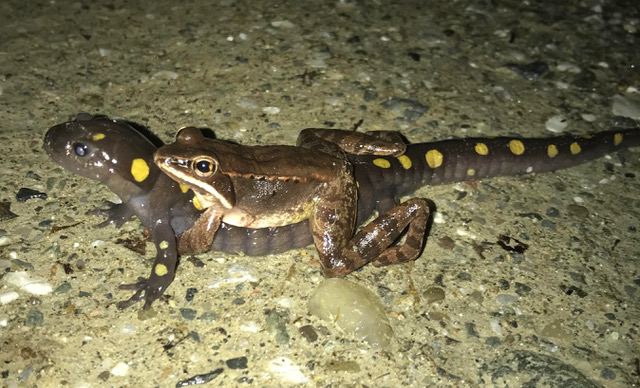
Herp Update: migration expected, reports, hormones — April 6, 2022
Amphibian Migration Expected Tomorrow Night (Thursday)
Herpers, the forecast for tomorrow night (Thursday) looks excellent for amphibian migration. Please take a look at our list of common amphibians that still need to be documented from your town. Just type in the name of the town you are interested in, or the species.
https://www.vtherpatlas.org/priorities-data-gaps/common-vermont-species-that-need-documentation/
If you could find and photograph any of these needed species, please do send us a report. You should also look at the list of the more unusual species that should always be reported:
https://www.vtherpatlas.org/priorities-data-gaps/always-report-most-wanted-and-rarest/
Not all species are moving this early in the spring; some such as Gray Treefrogs are waiting for warmer weather. However, there are many early season migrators. In addition to common species such as Spotted Salamander, Wood Frog, Spring Peeper, and Eastern Red-backed Salamander, some unusual species that are moving now are Boreal Chorus Frog, Jefferson Salamander, Blue-Spotted Salamander, and Four-Toed Salamander.
Any time you find one of these unusual species, we would like to hear about it.
Recent reports and misdirected hormones
Sandra M, Kate Kelly, and I visited our monitoring ponds in Lincoln yesterday afternoon and hundreds of Wood Frogs were calling and mating. Some of the mating balls out toward the middle of the pond included four or five males hanging on to one unfortunate female (the females are reddish). Around the edges of the ponds we found many pairs in amplexus.
We also found hundreds of Wood Frog egg-masses and a only a few Spotted Salamander egg masses. This is typical for the beginning of the mating season. The Spotted Salamanders will continue to arrive at the ponds and lay their eggs for the next few weeks. By the time the last Spotted Salamanders arrive at the ponds, the Wood Frog egg-masses will have hatched and disintegrated.
Wood Frogs are not particular about who they try to mate with. We have found them trying to mate with Spotted Salamanders, dead mammals, the tops of cattails, trout, and our fingers. The combination below is pretty common. It will not work.
Jim

Wood frog (L. sylvaticus) amplexing a Spotted Salamander (A. maculatum). Photo by Ashley Bray and used with permission.

